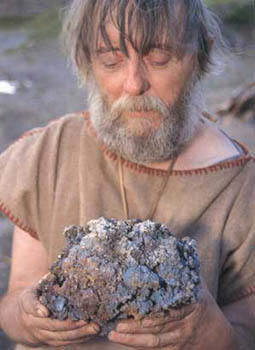Smelting Iron
The iron ore used at Byrkeknott was supplied by Ralph de Eure (of Witton Castle) and would have been local ironstone. In the Weardale region this would normally be in the form of 'nodules' , that is lumps, of ferrous carbonate (FeCO3) a. This would require preliminary 'roasting' to convert the ferrous carbonate to iron oxide which could then be converted to iron in the smelting process.
Roasting
"The principles of roasting differ somewhat from those of smelting. In roasting, we require a moderate temperature and, very often, oxidising conditions. Therefore, there is no need to keep out excess air, and a platform in the open is quite sufficient. Raw wood can be used and a lattice-like construction made on which the ore can be spread. It is quite unlikely that primitive peoples used bowl hearths or furnaces for roasting as these would be an unnecessary complication and relatively inefficient. The roasting reactions of the carbonate ores are :
FeCO3 --> FeO + CO2
(decomposition)
4FeO + O2 --> 2Fe2O3 (oxidation)
The drying or decomposition of hydrated ores of the limonite or bog iron ore type, proceeds according to the equation:
Fe2O3.H2O --> Fe2O3 + H2O
Naturally, large nodules are very slow to roast to completion and many specimens have been found which have been incompletely roasted. After partial roasting they may be broken more easily; it is possible that, in some cases, a second roasting was given to complete the process. "1
Principles of primitive iron smelting
"Iron may be reduced from pure iron oxide at about 800 °C, considerably below its melting point of 1540 °C. But iron ores do not consist only of iron oxides; they are mixtures of these and 'gangue' or unwanted mineral. Since it is not practicable to remove all the gangue by washing, a large amount must be seperated by 'slagging' in the smelting process. The slags mostly consist of a compound formed from iron oxide and silica (i.e. sand). As much as possible of these slags has to be removed from the iron by liquation, and therefore the smelting process must take place at or above the temperature at which the slags become sufficiently fluid to drain away from the solid iron. This temperature is about 1150 °C, well above the minimum temperature at which iron oxide can be reduced to iron, but substantially below the melting point of the metal. Thus iron is produced in the solid state as a sponge or raw bloom from which the slag partly drains away." 1
|
The main principle in iron smelting is the reduction of the metal oxide with carbon monoxide: Fe2O3 + 3CO --> 2Fe + 3CO2 The carbon monoxide is formed by partial combustion of charcoal. Iron working was a common element of everyday life in Iron Age Britain. By 500 BC iron had replaced bronze as the usual metal for making tools and weapons. Blacksmiths produced iron using charcoal-fired shaft furnaces. Iron ore was smelted to produce a 'bloom' (see the picture) which is a spongy mixture of metal and impurities. The bloom had to be further refined by repeated heating and hammering. |
 An iron bloom - from BBC - Ancient History in depth |
| A good article on the operation of a bloomery has been written by Roger Smith. Also see the Wikipedia article and references |
|
Notes
a Some siderite and limonite is found in close proximity to galena (lead ore) veins in Weardale. Bog iron deposits are also to be found around 8 inches under the moorland in suitable areas of Weardale.
b Bloomery - Note that it was important not to heat the iron too far in the smelting process since liquid iron, solidified, (pig iron) was too hard to work and of little value. It required a later development - the finery process - to reduce the carbon in remelted cast iron. The 'fined' iron was then forged into wrought iron in a chafery.
Ironstone - a sedimentary rock of which the main components are iron carbonate or oxide, clay and/or sand. Freshly cleaved ironstone is usually grey with a brown external appearance due to oxidation of its surface.
Blackband ironstone
A dark variety of clay ironstone containing sufficient carbonaceous matter (10% to 20%) to make it self-calcining (without the addition of extra fuel).
Jordanhill, Glasgow - At a depth of about 200 feet was the first of several beds of ironstone, a material had been identified while digging for coal seams. It was known as blackband ironstone and was of a high quality such that just over two tons of raw material could be smelted to give a ton of pure iron. The seams were generally quite thin, between 9 and 18 inches, so large quantities of surrounding material had to be brought to the surface in order to actually dig it. This resulted in huge bings of material such as blaes and clays and these bings led to the local industry of brickmaking.
References
1 R.F. Tylecote 'Metallurgy in Archaeology' pp 191, 183 published by Edward Arnold 1962
